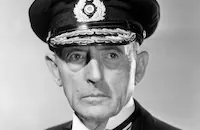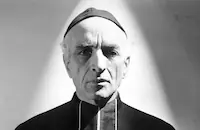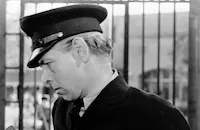The Song of Bernadette

Brief Synopsis
Cast & Crew
Henry King
William Eythe
Charles Bickford
Vincent Price
Lee J. Cobb
Gladys Cooper
Film Details
Technical Specs

Synopsis
On 11 Feb 1858, in the French village of Lourdes, François Soubirous and his wife Louise begin the daily struggle to provide for their daughters Bernadette and Marie and sons Justin and Jean. The poverty-stricken family lives in the town's former jail, which provides an unhealthy environment for the asthmatic Bernadette. Bernadette and Marie go to school, where Sister Marie Therese Vauzous is irritated by the fourteen-year-old Bernadette's ignorance. Because Bernadette has not learned her catechism, the imperious nun does not allow her to keep a holy picture given to her by Dean Marie Dominique Peyramale, and Bernadette asks her friend, Jeanne Abadie, to study at home with her. Louise sends the girls to gather wood, and while Jeanne and Marie wade ahead through the River Gave, Bernadette waits by the grotto of Massabielle. Bernadette is drawn to the cave's edge, where a beautiful Lady appears to her. Bernadette kneels before The Lady and says a rosary with her, but is wakened from her reverie by the reappearance of Jeanne and Marie. Bernadette describes The Lady, who was not seen by the other girls, but they are skeptical, as are Louise and François. The next day, Bernadette is overcome when she again sees The Lady, who asks her to visit fifteen times and tells her that she cannot promise Bernadette happiness in this world, only in the next. Frightened and concerned, Louise makes Bernadette promise never to return to Massabielle. The story of Bernadette's vision spreads through the village, until Bernarde Casterot, Louise's sister and Bernadette's godmother, insists that they accompany her to the grotto. The next morning, several others go with the family to Massabielle, and although no one else can see The Lady, Bernadette's exaltation convinces them that she is communicating with something glorious. The story spreads to other communities, and soon Mayor Alphonse Lacade, imperial prosecutor Vital Dutour, police commissioner Jacomet and other officials are upset by the ridicule being heaped upon Lourdes because of Bernadette's inexplicable actions. Dr. T. Duzous informs the men that, after examining Bernadette, he cannot diagnose her as mentally ill, and Father Peyramale also refuses to interfere, even though he does not believe in Bernadette's vision. Jacomet warns François that the entire family will be locked up if Bernadette's visits to the grotto do not cease, and Marie Therese punishes Bernadette by ridiculing her in front of her classmates. When Bernadette sobs that she will die if she cannot see The Lady, François gives her permission to return to Massabielle. There, The Lady, who has never told Bernadette her name, asks the girl to tell Peyramale to instruct the priests to build a chapel at the grotto, and to "let processions come hither." Peyramale reprimands the teenager, but then orders her to have her Lady perform a miracle to prove herself. Peyramale demands that The Lady make a rose bush in the grotto bloom, but instead, The Lady tells Bernadette to "eat of the plants" and "drink of the spring and wash there." The large crowd is appalled to see Bernadette choke down some weeds, then dig in the earth and rub mud over herself, and a stunned Louise leads the girl home. The jeering crowd applauds Jacomet's declaration that Bernadette is an idiot, but miller Antoine Nicolau, the girl's shy admirer, sees water trickle from the hole. When stonemason Louis Bouriette, who believes Bernadette, bathes his blind eye with the water, he can suddenly see. Convinced that the water has mysterious powers, Bouriette and Antoine lead others to build a stone channel for the flowing spring. That night, Croisine Bouhouhorts takes her dying son to the spring and he is revived by the cool water. Dozous is astonished to see that the toddler's paralysis has vanished, and the villagers proclaim that a miracle has occurred. All of France discusses the incident, and as Peyramale begins to wonder if Bernadette truly is a vessel of grace, hundreds of pilgrims converge on Lourdes. During the last of Bernadette's proscribed visits, she asks The Lady her name, but confesses to Peyramale that the answer--"I am the Immaculate Conception"--baffles her. Later, Lacade, who wants to profit from the miracles, reluctantly closes the grotto at the request of Dutour and Jacomet. Dutour invites a psychiatrist to examine Bernadette, but when the men attempt to institutionalize the girl, Peyramale defends her and takes her to the convent hospital for safekeeping. There, Marie Therese chastises Bernadette, telling her that in earlier times, she would have been burned at the stake for her actions. Meanwhile, Peyramale visits the Bishop of Tarbes and asks him to form an Episcopal Commission to investigate Bernadette's vision. The bishop agrees, but on the condition that the grotto be opened through The Lady's intercession. Soon the grotto is open at the behest of the Empress Eugénie, who believes that the waters cured her feverish son. In Nov 1860, the Commission begins an extensive examination of Bernadette, the grotto and the healings that have occurred. The years pass as Bernadette grows to womanhood, until finally the commission admits the possibility that she was "chosen by powers above." Peyramale tries to impress upon Bernadette the consequences of their findings, and although she fears the implications, she accepts the necessity of leaving the everyday world and becoming a nun. Bernadette goes to the Sisters of Nevers, and there again encounters Marie Therese, who is the Mistress of Novices. Marie Therese is a hard taskmaster to the twenty-year-old novice, but Bernadette patiently accepts her chores and her new name, Marie Bernarde. When Marie Therese sees Bernadette limping one day, she assumes that the girl is only seeking attention. Although she knows that even the Pope has accepted Bernadette's gift of holy vision, Marie Therese is still torn by doubt and asks the young woman what she knows of suffering. Marie Therese explains that she has deliberately led a severe life but has felt no touch of grace, and although Bernadette has no answer for the tormented sister, she finally shows her a large tumor on her knee. Bernadette is diagnosed with tuberculosis of the bone, which the doctor describes as unbearably painful. Astonished by the grace with which Bernadette has born her suffering, Marie Therese becomes the younger nun's devoted servant. As Bernadette grows weaker, the Commission questions her again, and she reaffirms her belief in The Lady. At Bernadette's bedside, Peyramale tries to calm her fears that she is not worthy enough to see her Lady again. As the sisters pray around her, Bernadette's face lights up and she cries out "I love you" upon seeing the beckoning Lady. Bernadette then dies, and Peyramale quietly states: "You are now in heaven and on earth. Your life begins, O Bernadette."

Director
Henry King
Cast

William Eythe

Charles Bickford

Vincent Price

Lee J. Cobb

Gladys Cooper

Anne Revere

Roman Bohnen

Mary Anderson

Patricia Morison
Aubrey Mather

Charles Dingle
Edith Barrett

Sig Ruman
Blanche Yurka
Ermadean Walters

Marcel Dalio
Pedro De Cordoba

Jerome Cowan

Jennifer Jones

Linda Darnell
Charles Waldron

Moroni Olsen

Nana Bryant
Manart Kippen
Merrill Rodin
Nino Pipitone Jr.
John Maxwell Hayes
Jean Del Val
Tala Birell
Eula Morgan

Frank Reicher
Charles La Torre

Nestor Paiva
Dorothy Shearer
Nino Pipitone
Edwin Stanley
Lionel Braham

Ian Wolfe
Andre Charlot
Irina Semochenko
Marie Carrozza
Joyce Miller
Alicia Diaz
Ruth Robinson

Geraldine Wall

Alan Napier
Eugene Borden
Edward Clark
Frank Leigh
Charles Bates
Harry Denny
Ernest Golm
Hans Herbert
George Gleboff

Edward Van Sloan
Tom Stevenson
Edward Fielding
John Dilson
Mayo Nehall
Curt Furberg
Armand Cortes
Louis Arco
George Sorel
Jean De Briac
Davison Clark
Antonio Filauri
Julian Rivero
Charles Wagenheim

Edward Keane
Hooper Atchley
Fred Essler

Harry Cording
Pat Dillon
Louis Mercier

Dickie Moore

Fritz Leiber

Arthur Hohl
Cecil Weston
Maria Pape
Marjorie Cooley

Mae Marsh
Fernanda Eliscu
Ruth Warren
Lucille Ward
Minerva Urecal
Claudine Le Duc
Alex Papana
Alphonse Martell
Muni Seroff
Frank Lackteen
Stephen Roberts
Margaret Hoffman
Connie Leon
Edythe Elliott
Elvira Curci
Adrienne D'ambricourt
Belle Mitchell
Frank Dae
Louis Bacigalupi
Crew
James Basevi
Joseph Behm
Lionel Bevans
Alfred Bruzlin
William Darling
Laure De Zarete
Father John Devlin
William Goetz
Roger Heman
Renè Hubert
Frank E. Hughes
Thomas Little
Barbara Mclean
Arthur Miller
Father Mullane
Alfred Newman
Guy Pearce
William Perlberg
Edward Powell
George Seaton
Ray Sebastian
Fred Sersen
Robert Webb

Photo Collections
Videos
Movie Clip



Trailer
Hosted Intro





Film Details
Technical Specs

Award Wins
Best Actress
Best Art Direction
Best Cinematography
Best Score
Award Nominations
Best Director
Best Editing
Best Picture
Best Sound
Best Supporting Actor
Best Supporting Actress
Best Supporting Actress
Best Writing, Screenplay
Articles
The Song of Bernadette
The Song of Bernadette also won Oscars® for Best Actress (Jennifer Jones), Art Direction and Music Score, and was nominated for Best Picture, Director, Supporting Actor (Charles Bickford), Supporting Actresses (Gladys Cooper and Anne Revere), Screenplay, Editing and Sound Recording. Jones' award was presented by Greer Garson, a fellow nominee for Madame Curie (1943) and the previous year's winner for Mrs. Miniver (1942). Always shy in crowds, Jones trembled as she spoke her brief thanks and, once off the podium, burst into tears.
Jones, protegee and later wife of producer David O. Selznick, was chosen for the role of Bernadette among what Fox claimed to be 2,000 applicants and a handful of finalists who made screen tests Ð among them Linda Darnell and Anne Baxter. Director King would recall, "A man stood behind the camera waving a stick. The other five did very well; but only Jennifer looked as if she saw a vision." Although studio press agents claimed that The Song of Bernadette was Jones' film debut, it was eventually discovered that under the name Phyllis Isley she had acted at RKO in a Dick Tracy serial and a "B" Western with John Wayne. The studio kept quiet about Jones' troubled marriage to fellow actor Robert Walker and their two children, leaving the press to assume she was single. Some Hollywood columnists, notably Louella Parsons, were resentful to learn later that they had been duped. Industry insiders reportedly had a good laugh from the casting of Darnell, the "current paramour" of studio head Darryl F. Zanuck, as the Virgin Mary.
Director: Henry King
Producer: William Perlberg
Screenwriter: George Seaton
Cinematographer: Arthur C. Miller
Music: Alfred Newman
Editor: Barbara McLean
Art Director: James Basevi, William S. Darling
Costume Designer: Rene Hubert
Cast: Jennifer Jones (Bernadette Soubirous), Charles Bickford (Peyramale Dean of Lourdes), William Eythe (Antoine Nocolau), Gladys Cooper (Sister Vauzous), Vincent Price (Dutour), Lee J. Cobb (Dr. Dozous), Anne Revere (Louis Soubirous), Tala Birell (Madame Bruat).
BW-157m.
by Roger Fristoe

The Song of Bernadette
Quotes
Wake up! Now! Else life is at an end for you. You are playing with fire, Bernadette.- Peyramale
There was something about the girl that precluded laughter.- Dr. Dozous
The spring is not for me.- Bernadette
Are you pert or just stupid?- Sister Marie Therese Verzous
I'm stupid, Sister.- Bernadette
Your Reverence, I DID see her.- Bernadette
Yes, my child, you did. And you will see her again.- Peyramale
Perhaps I haven't suffered enough.- Bernadette
You've suffered enough, my child, for the Heaven of Heavens.- Peyramale
If I understand you correctly, Doctor, science then excludes fraud; it excludes madness...I venture then to ask science, what is left?- Dutour
Yes, what IS left?- Dr. Dozous
Trivia
The film played continuously at a special theater in Lourdes dedicated to it exclusively.
Using an actress to play "the lady" was controversial enough, and further controversy fulminated when Loretta Young was passed over in favour of sultry Linda Darnell. At that time, Darnell had an almost pornographic reputation. Franz Werfel, the author of the book on which the film was based, threatened to remove his name from the project. To make matters worse, Darnell was pregnant. Nothing would change Darryl F. Zanuck's mind, and Werfel was told that an unknown actress was chosen. Wearing a little more drapery than the simple dress and veil described by the historical Bernadette, Darnell played the role in bright light.
Jennifer Jones had made other films before this, but only under her real name, Phyllis Isley. In an effort to make the public believe that she was "discovered" for this film, her screen credit reads "and introducing Jennifer Jones as Bernadette."
The movie's original score was partly composed by famous composer Igor Stravinsky but was subsequently rejected in favor of Alfred Newman's score. The second movement of Stravinsky's Symphony in Three Movements evolved out of the original unused score.
Notes
The opening title card of this film reads: "Twentieth Century-Fox presents Franz Werfel's The Song of Bernadette." After the opening credits, a written prologue reads: "This is the story of Bernadette Soubirous who lived in Lourdes, a village in southern France close to the Spanish border. For those who believe in God, no explanation is necessary. For those who do not believe in God, no explanation is possible." According to his introduction in his fictionalized biography of St. Bernadette (1844-1879), Werfel, who was Jewish, wrote about the peasant girl to fulfill a vow he made while he and his wife were escaping from the Germans in 1940. The couple hid in Lourdes for several weeks during their flight, and there Werfel learned the story of Bernadette, who saw visions of the Virgin Mary and discovered a spring at the grotto of Massabielle. Bernadette's description of The Lady as wearing a white dress and a blue girdle, with roses on her feet, has been used frequently in Roman Catholic iconography. The grotto, to which thousands of visitors still come each year, is regarded by the faithful as having miraculous healing powers. Werfel vowed that if he and his wife arrived safely in the United States, he would "sing, as best [he] could, the song of Bernadette," who was canonized in 1933. During his journey to the United States, Werfel began work on his book, which was published to great acclaim.
According to September 1941 Hollywood Reporter and Los Angeles Times news items, International Artists, Inc., which specialized in promoting "package deals," was the first company to acquire the rights to Werfel's novel and intended to hire William Dieterle as director. According to a June 1, 1942 Hollywood Reporter news item, Dieterle purchased an option on Werfel's book "a year ago in Europe but allowed his option to lapse," and Twentieth Century-Fox purchased the screen rights for $82,500. Modern sources list the book's selling price as $125,000. In July 1942, Hollywood Reporter announced that Werfel had started work at the studio, where he was to serve as a "production advisor, gathering materials and assisting" on the screenplay. Also in July 1942, Hollywood Reporter revealed that Twentieth Century-Fox had "opened negotiations for Lillian Gish to become the star of Song of Bernadette, with her wistful personality type believed ideal." In August 1942, Hollywood Reporter news items stated that Beatrice Pearson was being "secretly tested" for the lead role, and that producer William Perlberg was talking with Agnes Moorehead about performing the role of "Sister Marie Therese Vazous."
In August 1942, when Hollywood Reporter announced that Henry King had been set as the film's director, it was also noted that Anne Baxter was the "only definite cast assignment to date." A October 27, 1942 Hollywood Reporter news item revealed that Twentieth Century-Fox was receiving approximately 1,000 letters per week from the public with suggestions about the casting of "Bernadette" and the presentation of the story. The item stated that the studio had received approximately 20,000 letters to date, and that the "preponderance of letters from Catholic prelates favor Rita Quigley" to play the lead role. In a November 16, 1942 Hollywood Reporter news item, the studio reported: "The screen treatment of the book recently received the imprimatur of approval from the Catholic church after Monsignor Vincent Sheehan and two other Catholic prelates traveled to Hollywood to pass on the story." Although the news item announced that Jennifer Jones "definitely" had won the lead role, a 23 November Hollywood Reporter news item stated that Jones had merely been tested for the role, for which Mary Anderson would also be tested that week. The next day, Hollywood Reporter noted that Linda Darnell and Baxter would be tested as well. On December 9, 1942, Hollywood Reporter announced that Jones had been "handed the plum role of the year." Although the onscreen credits "introduce" Jones, and a number of reviews referred to her as a "newcomer," she had previously appeared in two Republic productions under the name Phylis Isley. Bernadette was Jones's first starring role, for which she was loaned to Twentieth Century-Fox by David O. Selznick, who agreed to share her contract with the studio in exchange for her being awarded the role. According to a modern source, Teresa Wright was one of the actresses who competed with Jones for the role.
According to a February 1943 Hollywood Reporter news item, Barbara Bushman, who was appearing in the studio's photographic still layout of the story for Life magazine, would be tested for the role of "Jeanne Abadie," which she was portraying for the magazine. March 1943 Hollywood Reporter news items noted that Mona Maris had been cast as "Empress Eugénie," and that before the casting of Charles Bickford as "Peyramale," the ten actors tested for the role included Donald Crisp, Walter Hampden, Lee J. Cobb [who appears in the film as "Dr. T. Duzous"], Thomas Mitchell and Sir Cedric Hardwicke. A studio publicity release stated that Lynne Roberts had been cast as "Sister Natalie," although the character does not appear in the completed picture. Both Roberts and Maris are listed on Hollywood Reporter production charts. Another press release lists Darnell in the role of "Sister Ramey," a character that is also not in the finished film. A June 25, 1943 Hollywood Reporter news item noted that Darnell's appearance as "The Lady" was not advertised when the film was released because the studio thought that "it would shatter the illlusion to have an actress connected with the part of the Virgin Mary." According to a August 6, 1943 Hollywood Reporter news item, when the picture went back into production for additional sequences, Jo-Carroll Dennison was included in the cast as "a young nun." Her appearance in the completed film has not been confirmed, however.
Numerous news items noted that King went on extensive location trips in search of locales to film the picture, but eventually a two-acre set, representing Lourdes and Massabielle, was built at the studio. News items cited transportation difficuties, labor shortages and the logistical problems of dealing with a very large cast as the reasons behind the studio's decision not to film on location. A May 2, 1943 New York Times article reported that one of the set requirements was a "450-foot-long section of the Gave River...thirty feet wide and three feet deep. At the top of the manufactured river bed is a reservoir which holds 170,000 gallons."
The picture received high praise from motion picture critics and Catholic organizations. Joseph I. Breen, head of the PCA, particularly liked the film, which he praised extensively. In a January 1944 letter, contained in the MPAA/PCA Collection at the AMPAS Library, Breen, in writing to a Chicago priest, reported that "Archbishop [John J.] Cantwell [of Los Angeles] was so favorably impressed with the picture that he sent out a letter to all the parish priests throughout the Archdiocese asking them to urge their people to see the picture at all costs." Breen received a letter from producer Perlberg in March 1944, thanking him for sending a clipping about the film that appeared in Columbia magazine. Perlberg confided: "Although I have never saved a clipping about my private life or any publicity on any motion picture I have made, I confess I am saving everything I can get hold of which has been written about 'Bernadette.'" Modern sources note that the popular novel was run as a daily comic strip in the San Francisco Herald Examiner after the film's release. An eighty-three by forty-two foot reproduction of Norman Rockwell's portrait of Jones as Bernadette hung over the marquee at the Rivoli Theatre in New York. Rockwell's portrait also appeared as the cover of the Decca record of the film's score.
Although the picture did not go into general release until 1945, it played extensive "roadshow" dates at advanced prices and was eligible for the 1943 Academy Awards. The film received the following Academy Awards: Best Actress (Jennifer Jones); Best Art Direction (b&w: James Basevi, William Darling, Thomas Little); Best Cinematography (b&w: Arthur Miller); and Best Music (scoring of a dramatic or comedy picture: Alfred Newman). The film also received the following Academy Award nominations: Best Picture; Best Supporting Actor (Charles Bickford); Best Supporting Actress (Gladys Cooper and Anne Revere); Best Direction (Henry King); Best Film Editing (Barbara MacLean); Best Sound Recording (Twentieth Century-Fox Studio Sound Department: E. H. Hansen, Sound Director); and Best Writing (Screenplay: George Seaton). The film was awarded a Golden Globe as the best picture of 1943, and Jones was named the year's best actress. The Song of Bernadette was also listed as one of the ten best films of 1944 by Film Daily Year Book and the National Board of Review.
Hollywood Reporter news items in late 1948 noted that the film was receiving "spectacular support" from the Catholic Church in Germany and Austria, with special buses carrying viewers from East Germany to the West for showings of the picture. The news items also claimed that Pope Pius XII, who "frequently" saw American films, had viewed The Song of Bernadette and was reported to be "enthusiastic" about it.
Charles Bickford reprised his role as Peyramale for two Lux Radio Theatre broadcasts. The first, co-starring Anne Baxter, aired on April 11, 1949, and on October 26, 1954, Ann Blyth was Bickford's co-star. Other versions of Bernadette's story include an hour-long television drama that aired on October 13, 1958. Ralph Alswang and Claudio Guzman directed the Quinn Martin production, entitled Bernadette, which starred Pier Angeli. Another television version, entitled Bernadette Soubrous, was produced by the BBC and aired in December 1958, with star Mary Webster. In 1988, Cannon France released Bernadette, a theatrical film produced in France by Jacques Quintard. Directed by Jean Delannoy, the French version starred Sydney Penny and Jean-Marc Bory.

Miscellaneous Notes
Released in United States 1943
Re-released in United States on Video March 5, 1996
Linda Darnell was not given screen credit.
Released in United States 1943
Re-released in United States on Video March 5, 1996














